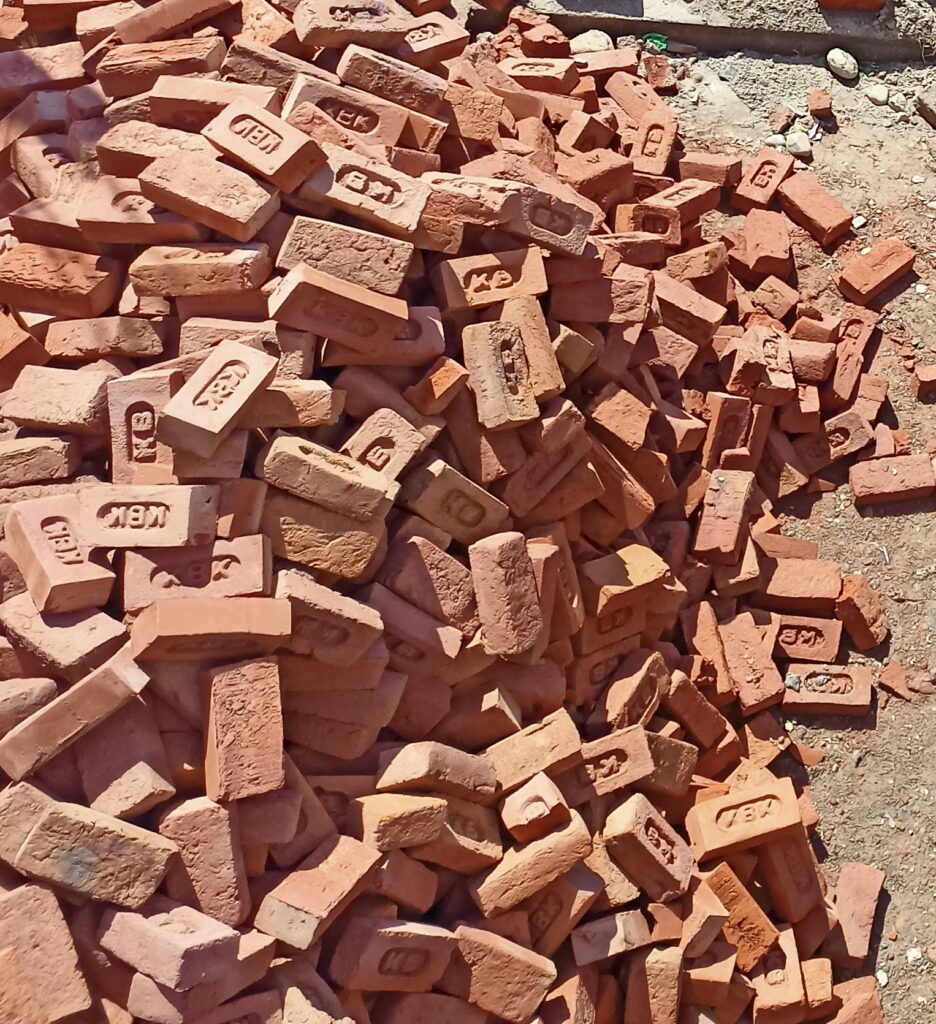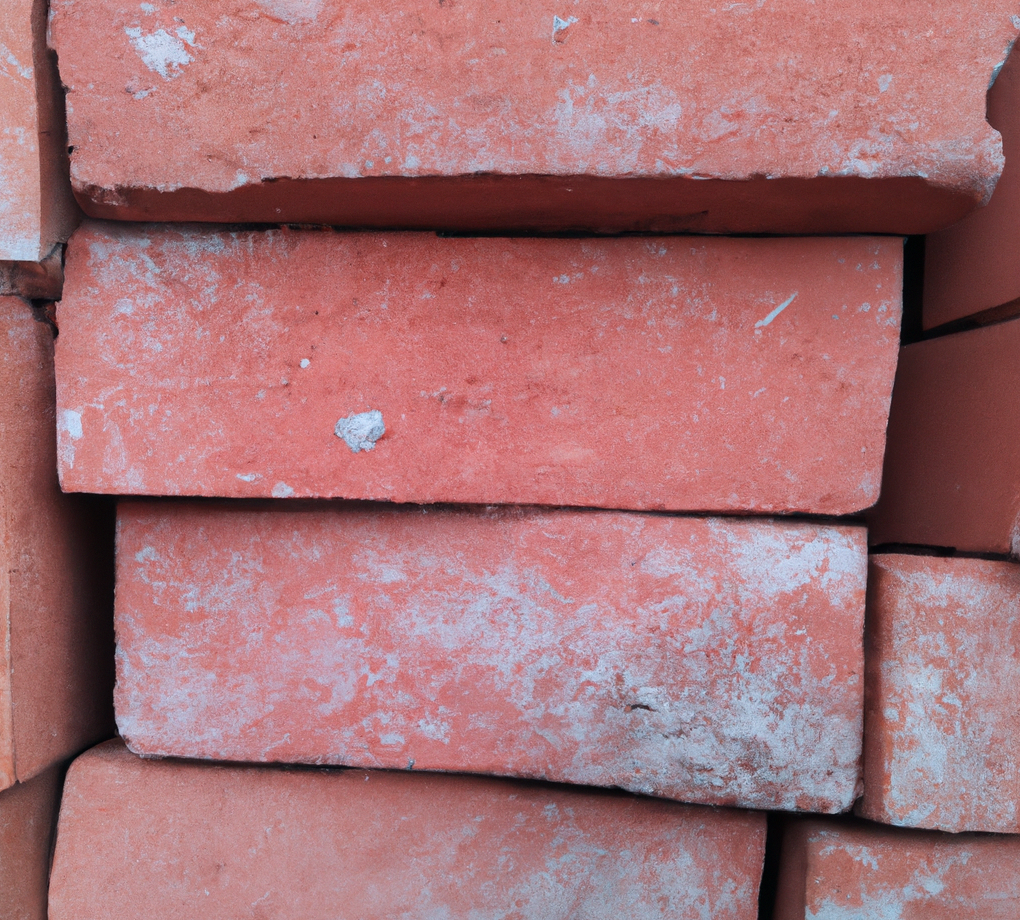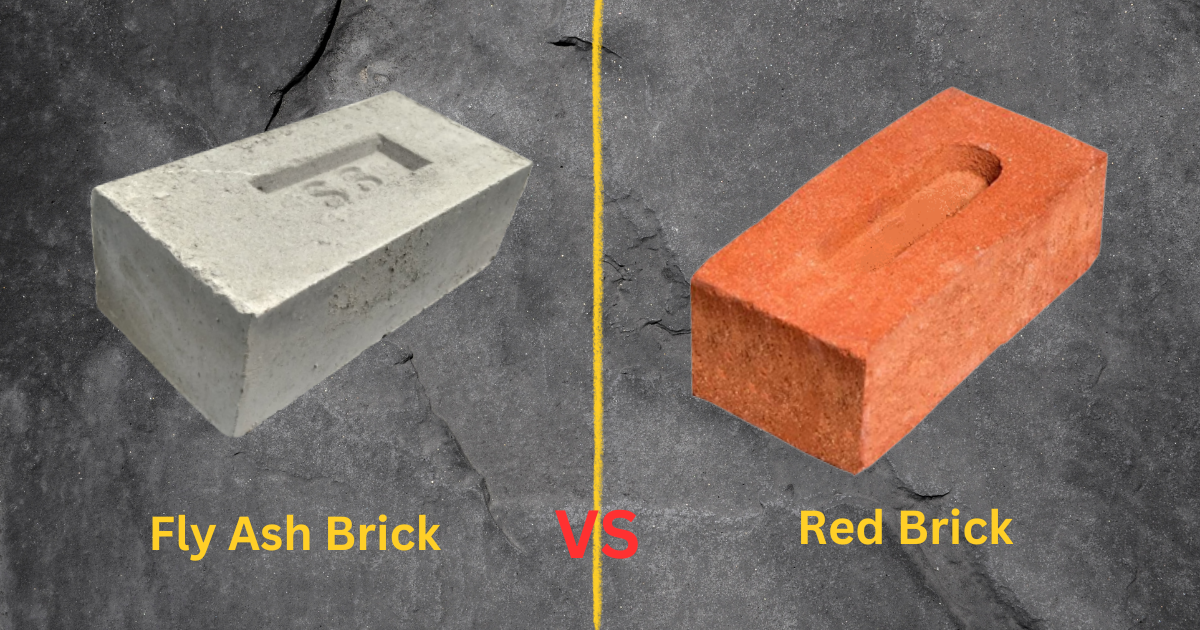When it comes to starting building a new house, it is important to select the right type of material for house construction. There are many possibilities, therefore it is necessary to consider things like cost, durability, and environmental impact. Here we will help you to make an informed decision about Fly ash or Red Bricks which brick is better for house construction?
Difference Between Fly Ash Bricks and Red bricks
Red Bricks are a preferable choice for load-bearing constructions due to their higher compressive strength, but fly ash bricks can be utilized for partition work in framed structures because the load is already supported by beams and columns.
Fly Ash Brick

Fly Ash bricks are lightweight bricks made up of ingredients like fly ash (a byproduct of coal combustion), sand, cement, gypsum, and lime. These bricks are strong, durable, and water-resistant. These are greyish in color and have the best cementing properties.
Ingredients of Fly Ash Brick
Fly Ash
Fly ash is a fine residual product that is obtained from the combustion of coal in power plants. It is commonly used as a supplementary cementitious material in the construction industry. It is utilized in the production of fly ash bricks, where it acts as a binding agent along with other materials.
Sand
Sand is a naturally occurring aggregate with a particle size smaller than 4.75 mm. The presence of silica content in sand helps to keep raw bricks by preventing shrinkage, breaking, and wrapping. It imparts a uniform shape to the bricks.
Cement
Ordinary Portland cement in the range of 5–10% is utilized.
Lime
Lime (CaCo3) should be present in a finely powdered state. It exhibits the adhesive property when mixed with water.
Gypsum
Gypsum is called hydrated calcium sulfate (CaSO4 x 2H2O). It is used to provide strength to the bricks.
Advantages of Fly ash brick
- These bricks save the overall cost of the project.
- Due to less weight, these bricks reduce the dead load of the structure.
- Fly Ash Bricks have a positive environmental impact as they are made from a byproduct of thermal power plants called fly ash, which would otherwise end up in landfills.
- Using fly ash bricks helps in reducing cement consumption as these do not require plastering on both wall faces.
- These bricks absorb less water.
Disadvantages of Fly ash brick:
- These bricks are not easily available everywhere as compared to red bricks.
- They are hard from the outer surface and soft from the inside which can cause cracking in the future with pipe fittings etc.
- Buildings made of fly ash bricks get quite cold in the winter since they do not absorb much heat.
- Bricks of a larger size break more frequently.
- It causes health hazards. It contains chemicals that can enter your lungs and, harm them permanently.
Red Brick

Red bricks are obtained by molding clay in rectangular blocks of uniform sizes. These are the oldest building material and it is extensively used at present as the leading material of construction because of their durability, strength, reliability, low cost, easy availability, etc. It comprises ingredients like Lime, Silica, Alumina, Iron oxide and Magnesia.
Ingredients of Red Brick
Alumina
It makes the earth plastic in nature so that it can be molded. A good brick earth should contain about 20% to 30% of alumina The raw bricks will shrink and warp during drying and burning if there is an excessive amount of alumina present and not enough sand.
Silica
It exists in clay either as a free or combined state. It is mechanically mixed with clay as free sand. Also, it exists in chemical composition with alumina in a combined form. A good brick earth should contain about 50% to 60% of silica.
Lime
Less quantity of lime not more than 5 percent is desirable in good brick earth. Due to the fact that even tiny particles smaller than a pinhead might cause the bricks to flake, they should be present in a very finely powdered form. It prevents the shrinkage of raw bricks.
Oxides of Iron
A small quantity of oxide of iron to the extent of about 5-6% is desirable in good brick earth. It helps as lime to fuse sand. It imparts a red color to the bricks. The higher content of oxide of iron makes the bricks dark blue or blackish.
Magnesia
A small amount of magnesia in brick earth imparts a yellow shade to the bricks and reduces shrinkage. But a higher percentage causes the decay of bricks.

Advantages of Red Brick
- Clay bricks have excellent thermal insulation properties.
- These are highly fire-resistant.
- The density of normal bricks helps to reduce sound transmission, making them effective in blocking out external noise.
- Clay bricks are made from natural materials, making them an environmentally friendly choice.
- These bricks can be recycled and reusable.
Disadvantages of Red Brick
- These are heavier in weight as compared to fly ash bricks.
- These bricks have a traditional and uniform appearance, which may not suit all architectural styles or design preferences.
- Each brick must be individually laid and mortared, which can slow down the construction timeline.
- These bricks absorb moisture and cause efflorescence.
Fly Ash Brick Vs Red Brick
| Fly Ash Brick | Red Brick |
| Its primary constituents are clay, lime, and sand. | Its primary constituents are fly ash, lime, and gypsum. |
| They possess lower compressive strength compared to red bricks. | Due to their high strength and durability, making them suitable for load-bearing structures. |
| These bricks do not require plastering. | These bricks require plastering on both the faces. |
| They are more environmentally friendly as it utilizes the waste product. | They emit carbon content to the atmosphere while burning. |
| They are non-porous. | They are porous. |
| They are greyish in color. | They are reddish brown in color. |
| It cost about Rs. 4-6 per unit. | It costs about Rs. 5-8 per unit. |
| These bricks do not cause efflorescence. | These bricks cause efflorescence. |
| They are light in weight nearly 2.6 Kgs. | They are heavier than fly ash bricks weighing around 3.5 Kg. |
FAQs
Which brick is better fly ash or normal red brick?
For load-bearing structures, selection of red brick is a better option due to its higher compressive strength. In framed structures, fly ash brick can be used for partition work as beams and columns already take the load.
Which brick is best for a house?
Choosing the right type of brick for house construction depends upon the type of structure, budget, and availability of the material.
Why fly ash bricks are not popular?
Due to their low mechanical strength and smaller sizes. Large-size bricks have more breakages.
What are the cheapest bricks?
Fly ash bricks are considered to be the cheapest bricks as compared to red bricks which cost around Rs. 4-6 per unit.
Which brick is better cement or clay?
Clay bricks can get damaged easily in wet or damp conditions. Cement bricks don’t last as long as clay bricks. Cement bricks remain effective for about 100 years, while clay bricks can last up to 1000 years.
Are Fly Ash Bricks environmentally friendly?
Yes, Fly Ash Bricks are considered eco-friendly as they utilize fly ash, a byproduct of thermal power plants, which would otherwise end up in landfills.
Also Read:
Steel Reinforcement Types and Properties Types of Aggregates (Coarse and Fine aggregates) | Properties and Use Auto Level Parts | Step-by-Step Guide for Beginners| 13 Best Types of Cement For Concrete Mix


